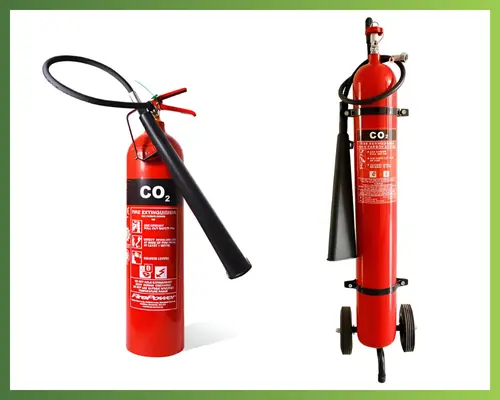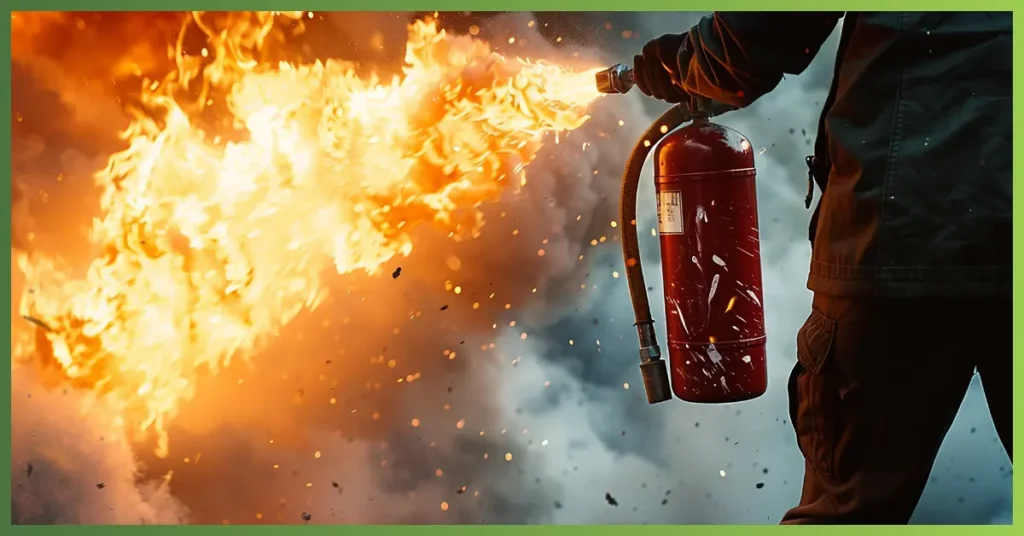What is a CO2 Fire Extinguisher?
CO2 fire extinguisher works best in extinguishing Class B & C which are – flammable liquids & electrical equipment. It achieves this by occupying the place of oxygen, thus disrupting the fire triangle, and it also has a cooling effect in order to prevent re-firing.
Types of CO2 Fire Extinguishers
Here are the different types of CO2 fire extinguishers:

1. Portable Fire Extinguisher CO2
These fire extinguishers are purposefully small and designed to be easy to pick up and use. Their sum weight is not greater than 10 kg. They are available in the following specifications:
- 2 kg
- 3 kg
- 4.5 kg
- 5 kg
2. Trolley Type Fire Extinguisher CO2
These fire extinguishers are larger and come with a trolley for easy maneuverability. Their total weight is more than 10 kg. They are available in the following specifications:
- 10 kg
- 20 kg
- 25 kg
- 30 kg
Both types of CO2 fire extinguishers are effective for Class B and C fires, providing versatile options for different fire safety needs. To get any type of fire extinguisher in Pakistan, contact Green Tech at 03211719229.
Overview of Sizes of CO2 Fire Extinguisher
SIZES | DESCRIPTION | USAGE |
2 kg | Compact and portable | Small offices, kitchens, or vehicles |
3 kg | Slightly larger for moderate coverage | Workshops or retail spaces |
4.5 kg | Popular mid-size for broader use | Medium-sized offices or industrial areas |
5 kg | Larger capacity for enhanced protection | Warehouses, server rooms, and larger spaces |
10 kg | Heavy-duty for extensive applications | Large-scale industrial and commercial areas |
How CO2 Fire Extinguishers Work
CO2 fire extinguishers extinguish fires by displacing oxygen, breaking the fire triangle, and producing a cooling effect to cool the fuel, thus preventing re-ignition.
Details of CO2 Fire Extinguishers
The cylinder of a CO2 extinguisher is filled with highly pressurized carbon dioxide gas. It features a strong horn that helps reduce the high pressure of the gas, which may turn into tiny pieces of dry ice when discharged.
Pressure and Temperature
CO2 extinguishers contain carbon dioxide at a high pressure of 55 bars (825 psi). At this pressure, the gas is in liquid form. Upon discharge, the pressure is reduced, and the gas exits in its gaseous form, effectively extinguishing the fire. The temperature of the CO2 gas is -60°C, which is sufficient to cool the fuel and remove heat from the fire.
Who Needs CO2 Extinguishers?
Anyone handling electrical or volatile liquid fire hazards needs a CO2 fire extinguisher.
- Retail Stores
- Data Center
- Hospitals and Labs
- Offices and IT Workspaces
- Factories and Workshops
- Storage Facilities and Warehouses
Co2 Fire Extinguisher Use
A CO2 fire extinguisher is used for Class B and C fires. Moreover, it is appropriate for electrical equipment.
Pros and Cons of CO2 Extinguis
Pros:
- Very efficient in dealing with electrical fires.
- May not leave behind any traces or residues when used
Cons:
- It is dangerous to hold the extinguisher by the horn as this can lead to cold burns.
- Not as eco friendly as other extinguisher types.
- They also displace oxygen in the surrounding area with CO2, which can lead to suffocation in case these are used indoors.
Applications of CO2 Fire Extinguishers
Here are the primary applications of CO2 extinguisher solutions:
Initial Fires in Various Settings
- Books and Archives: Protect valuable documents and archives without damaging them.
- Valuable Equipment: Safe for use on sensitive and high-value equipment.
- Precision Instruments: Ideal for protecting delicate and precise instruments.
- Electrical Equipment (below 600 volts): Safe for use in electrical fires without causing the conduction of electricity.
Suitable for Class B Fires
- Paraffin
- Diesel
- Crude Oil
- Methanol
- Ethanol
- Asphalt
- Paraffin
Suitable for Class C Fires
- Gas
- Natural Gas
- Methane
- Ethane
- Propane
- Hydrogen
Suitable for Class E Fires
- Electrically Burning Objects: Effective for fires where the primary source of ignition involves electrical equipment and installations.
These applications make CO2 fire extinguishers an important safety tool in environments such as laboratories, server rooms, oil refineries, and places where sensitive and valuable equipment is used or stored.
How to Use a CO2 Fire Extinguisher?
A CO2 fire extinguisher is simple to use, but it needs caution and care. Take these steps into account:
- Pull the Pin: To break the seal and get the extinguisher ready for use.
- Aim the Nozzle: To successfully extinguish the fire, aim the extinguisher’s horn at the fire’s base rather than the flames.
- Squeeze the Lever: To release the CO2, press the handle or lever. Hold the extinguisher tightly.
- Sweep Side to Side: Until the fire is totally extinguished, move the nozzle in a sweeping manner across the fire’s base.
- Remain Back: Keep a safe distance of one to three meters.
- Re-Ignition: Make sure the area doesn’t catch fire again.
Identification of C02 Fire Extinguishers
CO2 fire extinguishers have a red cylinder with a black label for easy identification.
Co2 Cylinder Price in Pakistan
CO2 cylinder price in Pakistan varies depending on the size and brand, with options ranging from 1 kg to 50 kg, including brands like Naffco (UAE), Bavaria (Germany), and others from China.
Difference Between DCP and CO2 Fire Extinguisher
Here’s the difference between DCP (Dry Chemical Powder) fire extinguishers and CO₂ (Carbon Dioxide) fire extinguishers
1. Extinguishing Agent
- DCP Fire Extinguisher:
DCP fire extinguishers contain a dry chemical powder, commonly monoammonium phosphate or sodium bicarbonate.
- CO₂ Fire Extinguisher: Uses carbon dioxide gas.
2. How They Work?
- DCP:
DCP creates a protective layer over the fire, blocks oxygen, and prevents it from spreading.
- CO₂ Displaces oxygen around the fire and cools it down to put it out.
3. Suitable Fire Types
- DCP: Effective on Class A (wood, paper, fabric), Class B (flammable liquids), and Class C (electrical) fires.
- CO₂: Ideal for Class B (flammable liquids) and Class C (electrical) fires but not recommended for Class A fires.
4. Residue & Cleanup
- DCP: Leaves a messy powder that needs cleaning after use.
- CO₂: Leaves no residue, making it ideal for places with electrical equipment.
5. Common Uses
- DCP: Found in homes, factories, and vehicles because it works on multiple fire types.
- CO₂: Used in offices, server rooms, and electrical panels to avoid equipment damage.
In short, DCP is more versatile but messy, while CO₂ is clean and best for electrical fires.
FAQs
CO2 fire extinguishers are used to put out electrical fires and fires caused by flammable liquids like oils, petrol, etc.
A CO2 fire extinguisher is used to extinguish Class B and electrical fires.
CO2 stands for Carbon Dioxide fire extinguisher, which is a gas
No, CO2 is not considered ABC extinguishers because they are mainly for Class B and electrical fires. On the contrary, ABC fire extinguishers are well suited for Class A, B, and C fires.
CO₂ fire extinguishers are effective for extinguishing fires involving flammable liquids (Class B) and electrical equipment (Class C).
Wrapping Up
In conclusion, a CO2 fire extinguisher is appropriate for electrical equipment and can be used to put out Class B and C fires.
Computer labs, server rooms, telecoms, gas stations, and the oil industry are all ideal locations for these extinguishers.
Therefore, GreenTech Solutions provides you with the greatest imported CO2 fire extinguishers, regardless of the size or brand you’re seeking for.


